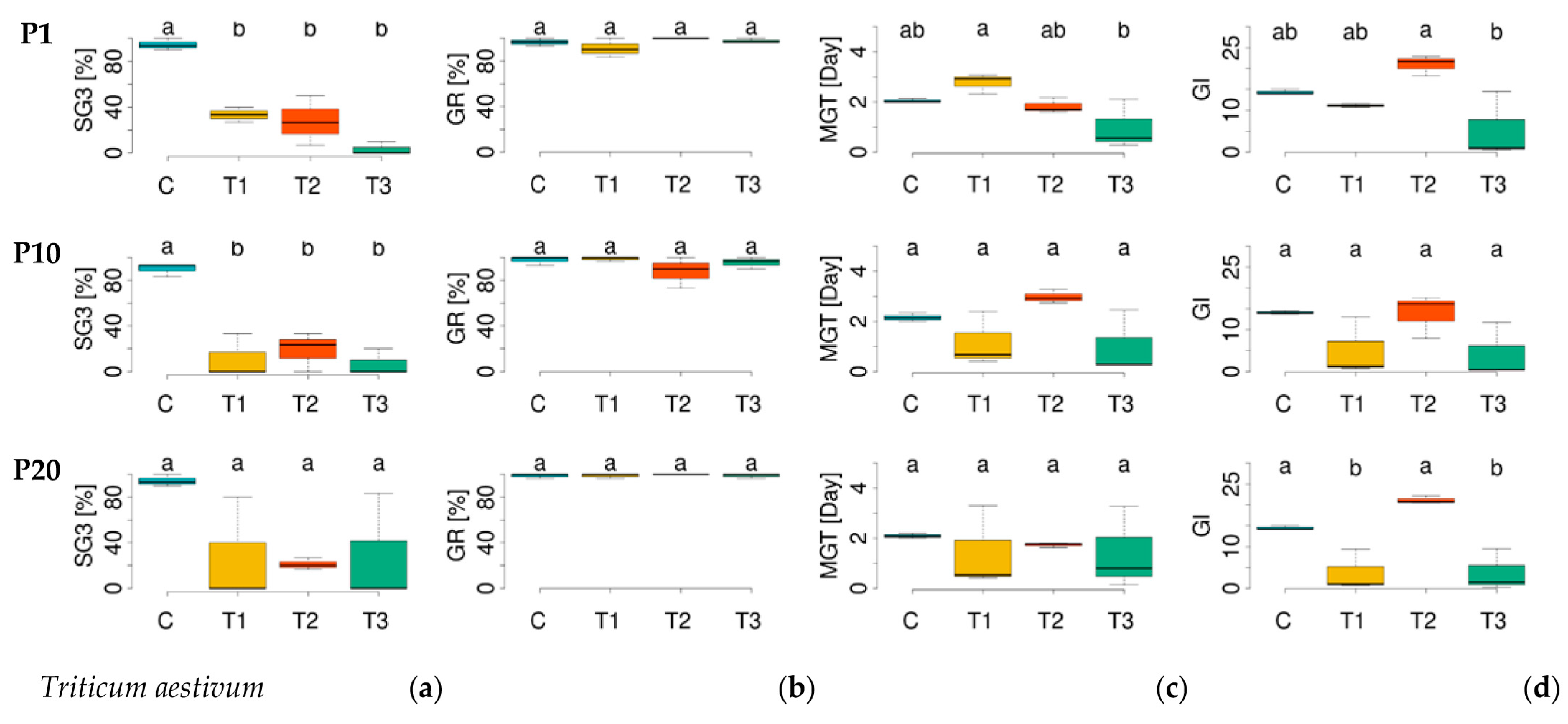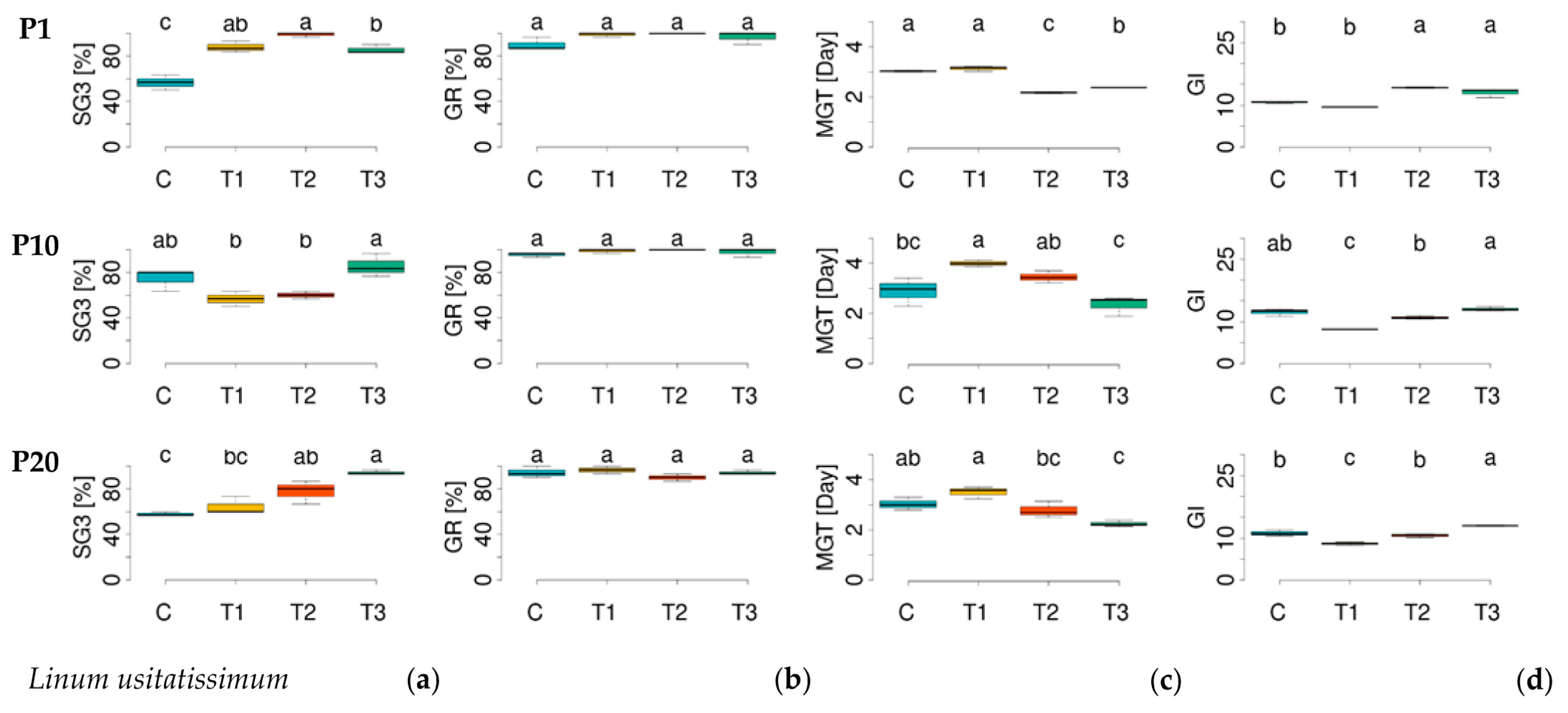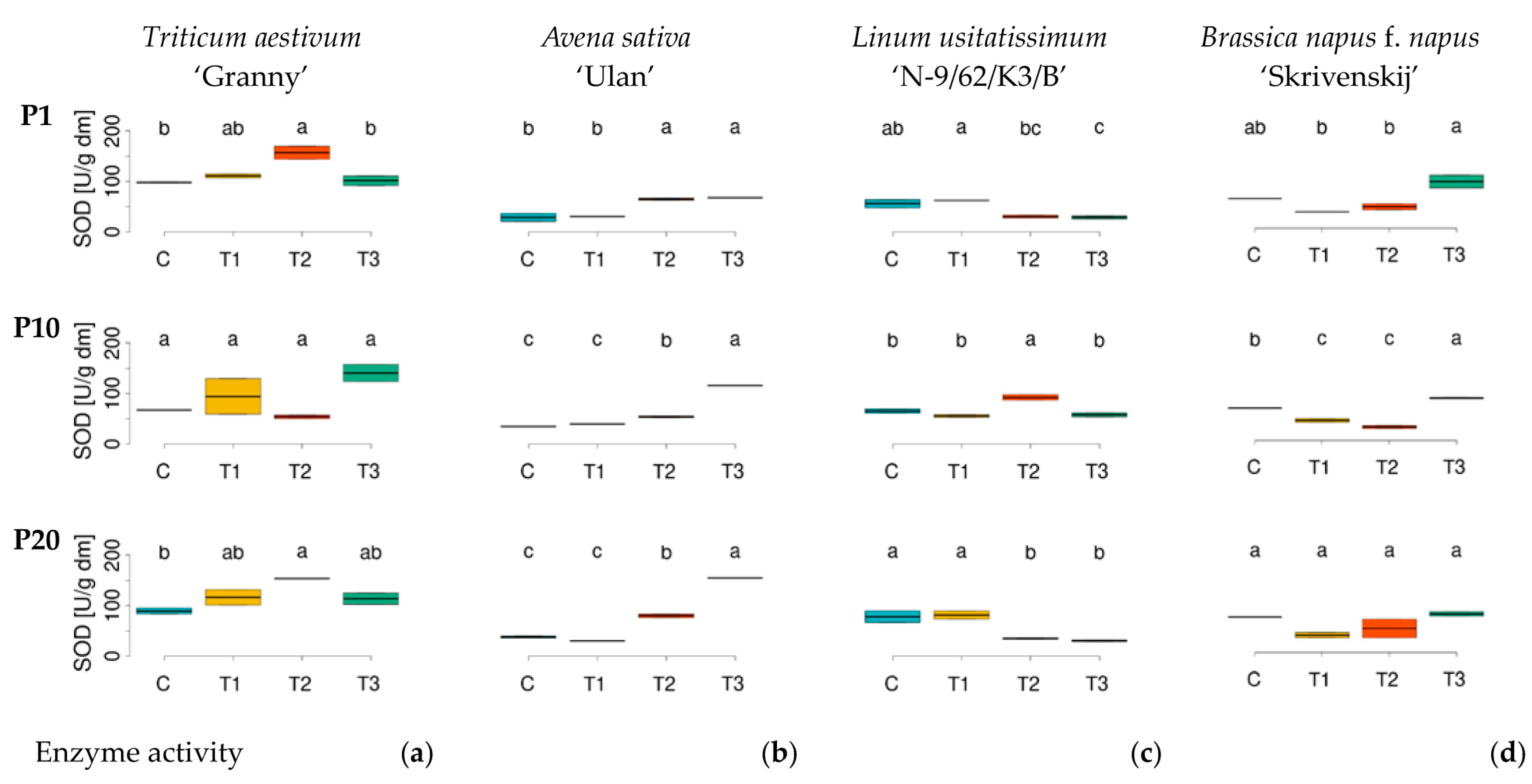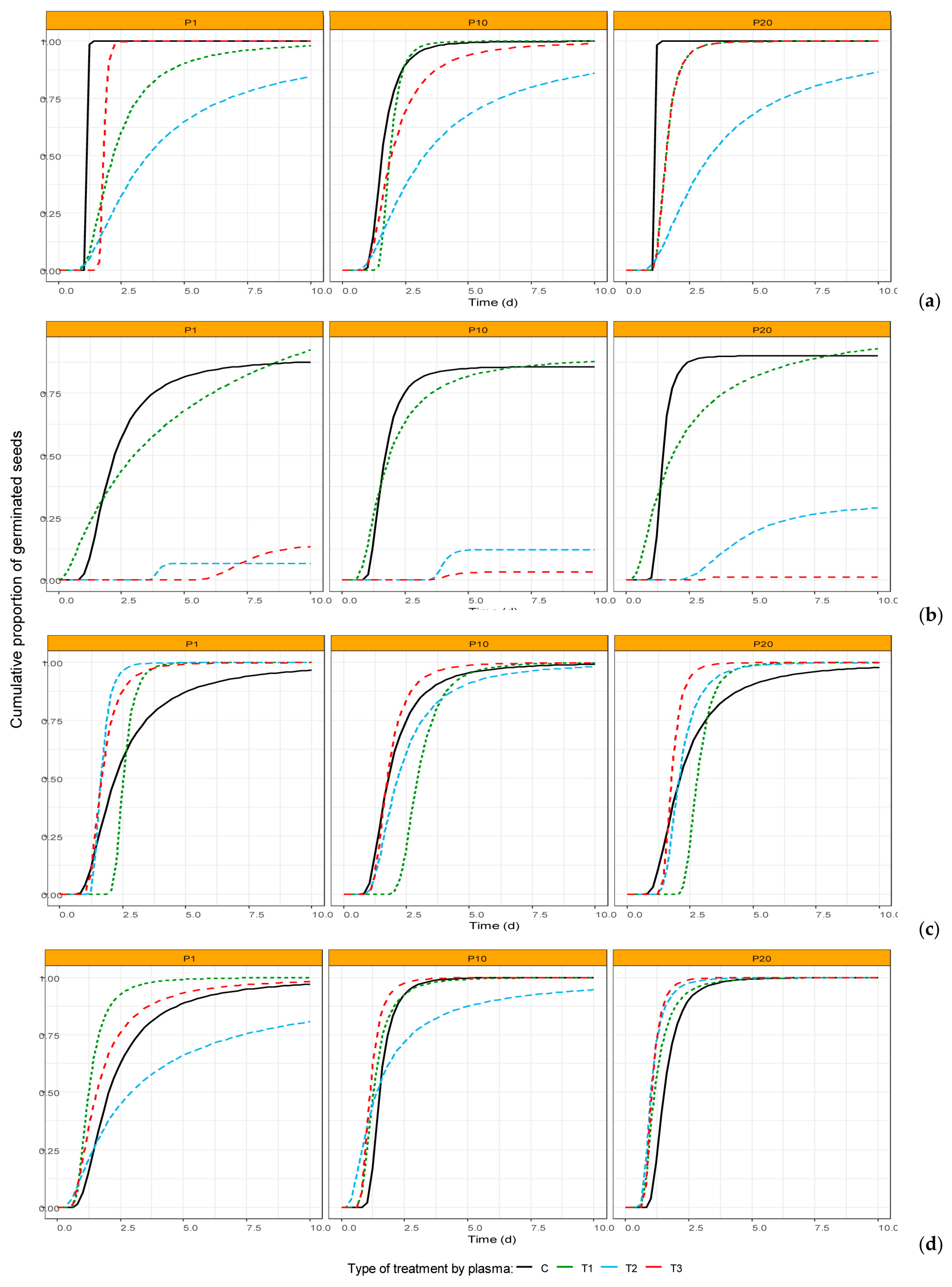Evaluation of the Effect of Low-Temperature Plasma Treatment on Seed Germination of Long-Term Stored Genetic Resources
Abstract
:1. Introduction
2. Materials and Methods
2.1. Genotypes Used in the Study
2.2. Plasma Treatment
2.3. Germination Evaluation
2.4. Determination of Superoxide Dismutase (SOD) Activity
2.5. Statistical Analyses
3. Results
- likelihood ratio test for Triticum aestivum = 241.8502; d.f. = 22; p-value = 6.101 < 0.001;
- likelihood ratio test for Avena sativa = 1075.7515; d.f. = 33; p-value = 1.063 < 0.001;
- likelihood ratio test for Linum usitatissimum = 577.8142; d.f. = 22; p-value = 3.911 < 0.001
- likelihood ratio test for Brassica napus f. napus = 423.8978; d.f. = 22; p-value = 4.733 < 0.
4. Discussion
5. Conclusions
Supplementary Materials
Author Contributions
Funding
Data Availability Statement
Acknowledgments
Conflicts of Interest
References
- Borner, A. Preservation of plant genetic resources in the biotechnology era. Biotechnol. J. 2006, 1, 1393–1404. [Google Scholar] [CrossRef] [PubMed]
- Aubry, S. Genebanking plant genetic resources in the postgenomic era. Agric. Hum. Values 2023, 40, 961–971. [Google Scholar] [CrossRef]
- Don, R. ISTA Handbook on Seedling Evaluation; Basserdorf, E., Ed.; ISTA: Essen, Germany, 2009. [Google Scholar]
- Lee, J.-W.; Jo, I.-H.; Kim, J.-U.; Hong, C.-E.; Kim, Y.-C.; Kim, D.-H. Improvement of seed dehiscence and germination in ginseng by stratification, gibberellin, and/or kinetin treatments. Hortic. Environ. Biotechnol. 2018, 59, 293–301. [Google Scholar] [CrossRef]
- Li, T.S.C.; Bedford, K.E.; Sholberg, P.L. Improved germination of American ginseng seeds under controlled environments. HortTechnology 2000, 10, 131–135. [Google Scholar] [CrossRef]
- Blaszczak, W.; Doblado, R.; Frias, J.; Vidal-Valverde, C.; Sadowska, J.; Fornal, J. Microstructural and biochemical changes in raw and germinated cowpea seeds upon high-pressure treatment. Food Res. Int. 2007, 40, 415–423. [Google Scholar] [CrossRef]
- Taylor, A.G.; Allen, P.S.; Bennett, M.A.; Bradford, K.J.; Burris, J.S.; Misra, M.K. Seed enhancements. Seed Sci. Res. 1998, 8, 245–256. [Google Scholar] [CrossRef]
- Bisen, K.; Keswani, C.; Patel, J.S.; Sarma, B.K.; Singh, H.B. Trichoderma spp.: Efficient Inducers of Systemic Resistance in Plants. In Microbial-Mediated Induced Systemic Resistance in Plants; Choudhary, D.K., Varma, A., Eds.; Springer Nature Singapore: Singapore, 2016; pp. 185–195. [Google Scholar]
- Fariman, A.B.; Abbasiliasi, S.; Abdullah, S.N.A.; Saud, H.M.; Wong, M.Y. Stenotrophomonas imaltophilia isolate UPMKH2 with the abilities to suppress rice blast disease and increase yield a promising biocontrol agent. Physiol. Mol. Plant Pathol. 2022, 121, 101872. [Google Scholar] [CrossRef]
- Lee, Y.; Lee, Y.Y.; Kim, Y.S.; Balaraju, K.; Mok, Y.S.; Yoo, S.J.; Jeon, Y. Enhancement of seed germination and microbial disinfection on ginseng by cold plasma treatment. J. Ginseng. Res. 2021, 45, 519–526. [Google Scholar] [CrossRef] [PubMed]
- Hassan, S.; Zeng, X.A.; Khan, M.K.; Farooq, M.A.; Ali, A.; Kumari, A.; Mahwish; Rahaman, A.; Tufail, T.; Liaqat, A. Recent developments in physical invigoration techniques to develop sprouts of edible seeds as functional foods. Front. Sustain. Food Syst. 2022, 6, 997261. [Google Scholar] [CrossRef]
- Attri, P.; Ishikawa, K.; Okumura, T.; Koga, K.; Shiratani, M. Plasma Agriculture from Laboratory to Farm: A Review. Processes 2020, 8, 1002. [Google Scholar] [CrossRef]
- Govindaraj, M.; Masilamani, P.; Alex Alert, V.; Bhaskaran, M. Effect of physical seed treatment on yield and quality of crops: A review. Agric. Rev. 2017, 38, 1–14. [Google Scholar] [CrossRef]
- Strejckova, M.; Bohata, A.; Olsan, P.; Havelka, Z.; Kriz, P.; Beran, P.; Bartos, P.; Curn, V.; Spatenka, P. Enhancement of the Yield of Crops by Plasma and Using of Entomopathogenic and Mycoparasitic Fungi: From Laboratory to Large-Field Experiments. J. Biomater. Tissue Eng. 2018, 8, 829–836. [Google Scholar] [CrossRef]
- Mildaziene, V.; Ivankov, A.; Sera, B.; Baniulis, D. Biochemical and Physiological Plant Processes Affected by Seed Treatment with Non-Thermal Plasma. Plants 2022, 11, 856. [Google Scholar] [CrossRef] [PubMed]
- Ivankov, A.; Zukiene, R.; Nauciene, Z.; Degutyte-Fomins, L.; Filatova, I.; Lyushkevich, V.; Mildaziene, V. The Effects of Red Clover Seed Treatment with Cold Plasma and Electromagnetic Field on Germination and Seedling Growth Are Dependent on Seed Color. Appl. Sci. 2021, 11, 4676. [Google Scholar] [CrossRef]
- Billah, M.; Sajib, S.A.; Roy, N.C.; Rashid, M.M.; Reza, M.A.; Hasan, M.M.; Talukder, M.R. Effects of DBD air plasma treatment on the enhancement of black gram Vigna mungo l. seed germination and growth. Arch. Biochem. Biophys. 2020, 681, 108253. [Google Scholar] [CrossRef] [PubMed]
- Liu, C.C.; Cui, J.F.; Zhang, D.; Tang, H.W.; Gong, B.; Zu, S.X.; Zhong, C.S. Decontamination of infected plant seeds utilizing atmospheric gliding arc discharge plasma treatment. Plasma Sci. Technol. 2021, 23, 105501. [Google Scholar] [CrossRef]
- Skarpa, P.; Klofác, D.; Krcma, F.; Simecková, J.; Kozáková, Z. Effect of Plasma Activated Water Foliar Application on Selected Growth Parameters of Maize Zea mays L. Water 2020, 12, 3545. [Google Scholar] [CrossRef]
- Puac, N.; Gherardi, M.; Shiratani, M. Plasma agriculture: A rapidly emerging field. Plasma Process. Polym. 2018, 15, 1700174. [Google Scholar] [CrossRef]
- Konchekov, E.M.; Gusein-zade, N.; Burmistrov, D.E.; Kolik, L.V.; Dorokhov, A.S.; Izmailov, A.Y.; Shokri, B.; Gudkov, S.V. Advancements in Plasma Agriculture: A Review of Recent Studies. Int. J. Mol. Sci. 2023, 24, 15093. [Google Scholar] [CrossRef]
- Wu, Y.J.; Yu, S.Y.; Zhang, X.Y.; Wang, X.Z.; Zhang, J.J. The Regulatory Mechanism of Cold Plasma in Relation to Cell Activity and Its Application in Biomedical and Animal Husbandry Practices. Int. J. Mol. Sci. 2023, 24, 7160. [Google Scholar] [CrossRef]
- Li, L.; Li, J.G.; Shen, M.C.; Zhang, C.L.; Dong, Y.H. Cold plasma treatment enhances oilseed rapeseed seed germination under drought stress. Sci. Rep. 2015, 5, 13033. [Google Scholar]
- Priatama, R.A.; Pervitasari, A.N.; Park, S.; Park, S.J.; Lee, Y.K. Current Advancements in the Molecular Mechanism of Plasma Treatment for Seed Germination and Plant Growth. Int. J. Mol. Sci. 2022, 23, 4609. [Google Scholar] [CrossRef]
- Jezek, S.; Horcicka, P.; Jozová, E.; Curn, V. Comparison of the effect of additives during gliding arc plasma treatment on the germination of common bunt spores and growth characteristics of wheat. Plant Prot. Sci. 2023, 59, 256–263. [Google Scholar] [CrossRef]
- Leti, L.I.; Gerber, I.C.; Mihaila, I.; Galan, P.M.; Strajeru, S.; Petrescu, D.E.; Cimpeanu, M.M.; Topala, I.; Gorgan, D.L. The Modulatory Effects of Non-Thermal Plasma on Seed’s Morphology, Germination and Genetics—A Review. Plants 2022, 11, 2181. [Google Scholar] [CrossRef] [PubMed]
- Khamsen, N.; Onwimol, D.; Teerakawanich, N.; Dechanupaprittha, S.; Kanokbannakorn, W.; Hongesombut, K.; Srisonphan, S. Rice (Oryza sativa L.) Seed Sterilization and Germination Enhancement via Atmospheric Hybrid Nonthermal Discharge Plasma. ACS Appl. Mater. Interfaces 2016, 8, 19268–19275. [Google Scholar] [CrossRef]
- Nelson, S.O.; Kehr, W.R.; Stetson, L.E.; Wolf, W.W. Laboratory germination and sand emergence responses of alfalfa seed to radiofrequency electrical treatment. Crop. Sci. 1977, 17, 534–538. [Google Scholar] [CrossRef]
- Dobrin, D.; Magureanu, M.; Mandache, N.B.; Ionita, M.D. The effect of non-thermal plasma treatment on wheat germination and early growth. Innov. Food Sci. Emerg. Technol. 2015, 29, 255–260. [Google Scholar] [CrossRef]
- Hui, Y.T.; Wang, D.C.; You, Y.; Shao, C.Y.; Zhong, C.S.; Wang, H.D. Effect of Low Temperature Plasma Treatment on Biological Characteristics and Yield Components of Wheat Seeds (Triticum aestivum L.). Plasma Chem. Plasma Process. 2020, 40, 1555–1570. [Google Scholar] [CrossRef]
- Rasooli, Z.; Barzin, G.; Mahabadi, T.D.; Entezari, M. Stimulating effects of cold plasma seed priming on germination and seedling growth of cumin plant. S. Afr. J. Bot. 2021, 142, 106–113. [Google Scholar] [CrossRef]
- Saberi, M.; Modarres-Sanavy, S.A.M.; Zare, R.; Ghomi, H. Improvement of Photosynthesis and Photosynthetic Productivity of Winter Wheat by Cold Plasma Treatment under Haze Condition. J. Agric. Sci. Technol. 2019, 21, 1889–1904. [Google Scholar]
- Sajib, S.A.; Billah, M.; Mahmud, S.; Miah, M.; Hossain, F.; Omar, F.B.; Roy, N.C.; Hoque, K.M.F.; Talukder, M.R.; Kabir, A.H.; et al. Plasma activated water: The next generation eco-friendly stimulant for enhancing plant seed germination, vigor and increased enzyme activity, a study on black gram (Vigna mungo L.). Plasma Chem. Plasma Process. 2020, 40, 119–143. [Google Scholar] [CrossRef]
- Munekata, P.E.S.; Domínguez, R.; Pateiro, M.; Lorenzo, J.M. Influence of Plasma Treatment on the Polyphenols of Food Products—A Review. Foods 2020, 9, 929. [Google Scholar] [CrossRef] [PubMed]
- Dhayal, M.; Lee, S.Y.; Park, S.U. Using low-pressure plasma for Carthamus tinctorium L. seed surface modification. Vacuum 2006, 80, 499–506. [Google Scholar] [CrossRef]
- de Melo, R.B.; Franco, A.C.; Silva, C.O.; Piedade, M.T.F.; Ferreira, C.S. Seed germination and seedling development in response to submergence in tree species of the Central Amazonian floodplains. AoB Plants 2015, 7, plv041. [Google Scholar] [CrossRef] [PubMed]
- Gelmond, H. Problems in Crop Seed Germination in Crop Physiology; Gupta, V.S., Ed.; Oxford and IBH Publishing Co.: New Delhi, India, 1978; pp. 1–78. [Google Scholar]
- Yamaguchi, S.; Nambara, E. Seed development and germination. In Plant Hormone Signalling; Hedden, P., Thomas, S.G., Eds.; Blackwell Publishing Ltd.: Oxford, UK, 2006. [Google Scholar]
- Rajjou, L.; Duval, M.; Gallardo, K.; Catusse, J.; Bally, J.; Job, C.; Job, D. Seed Germination and Vigor. Ann. Rev. Plant Biol. 2012, 63, 507–533. [Google Scholar] [CrossRef]
- Bewley, J.D.; Bradford, K.J.; Hilhorst, H.M.W.; Nonogaki, H. Seeds. In Physiology of Development, Germination and Dormancy, 3rd ed.; Springer: New York, NY, USA, 2013. [Google Scholar]
- Carrera-Castaño, G.; Calleja-Cabrera, J.; Pernas, M.; Gómez, L.; Oñate-Sánchez, L. An Updated Overview on the Regulation of Seed Germination. Plant 2020, 9, 703. [Google Scholar] [CrossRef] [PubMed]
- Foyer, C.H.; Ruban, A.V.; Noctor, G. Viewing oxidative stress through the lens of oxidative signalling rather than damage. Biochem. J. 2017, 474, 877–883. [Google Scholar] [CrossRef] [PubMed]
- Altman, A.; Fan, L.J.; Foyer, C.; Cowling, W.; Mittler, R.; Qaim, M.; Weber, A.P.M.; Reynolds, M.; Varshney, R.K.; Fernie, A. Past and Future Milestones of Plant Breeding. Trends Plant Sci. 2021, 26, 530–538. [Google Scholar]
- Diaz-Vivancos, P.; Barba-Espín, G.; Hernández, J.A. Elucidating hormonal/ROS networks during seed germination: Insights and perspectives. Plant Cell Rep. 2013, 32, 1491–1502. [Google Scholar] [CrossRef]
- Kumar, S.P.J.; Prasad, S.R.; Banerjee, R.; Thammineni, C. Seed birth to death: Dual functions of reactive oxygen species in seed physiology. Ann. Bot. 2015, 116, 663–668. [Google Scholar] [CrossRef]
- Qu, T.B.; Peng, Y.L.; Yang, C.X.; Du, X.; Guo, W.Q.; Zhang, J.F. Single and Combined Effects of Cadmium and Lead on Seed Germination and Early Seedling Growth in Rhus typhina. Pol. J. Environ. Stud. 2021, 30, 823–831. [Google Scholar] [CrossRef]
- Roy, N.C.; Hasan, M.M.; Talukder, M.R.; Hossain, M.D.; Chowdhury, A.N. Prospective Applications of Low Frequency Glow Discharge Plasmas on Enhanced Germination, Growth and Yield of Wheat. Plasma Chem. Plasma Process. 2018, 38, 13–28. [Google Scholar] [CrossRef]
- Li, Y.J.; Wang, T.C.; Meng, Y.R.; Qu, G.Z.; Sun, Q.H.; Liang, D.L.; Hu, S.B. Air Atmospheric Dielectric Barrier Discharge Plasma Induced Germination and Growth Enhancement of Wheat Seed. Plasma Chem. Plasma Process. 2017, 37, 1621–1634. [Google Scholar] [CrossRef]
- Aravind, J.; Vimala Devi, S.; Radhamani, J.; Jacob, S.; Srinivasan, K. Germinationmetrics: Seed Germination Indices and Curve Fitting. R Package Version 0.1.8. Available online: https://aravind-j.github.io/germinationmetrics/ (accessed on 19 February 2024).
- Elavarthi, S.; Martin, B. Spectrophotometric Assays for Antioxidant Enzymes in Plants. In Plant Stress Tolerance. Methods in Molecular Biology; Sunkar, R., Ed.; Human Press: Devon, UK, 2010; Volume 639. [Google Scholar]
- Zhang, C.; Bruins, M.E.; Yang, Z.Q.; Liu, S.T.; Rao, P.F. A new formula to calculate activity of superoxide dismutase in indirect assays. Anal. Biochem. 2016, 503, 65–67. [Google Scholar] [CrossRef]
- Onofri, A.; Mesgaran, M.B.; Ritz, C. A unified framework for the analysis of germination, emergence, and other time-to-event data in weed science. Weed Sci. 2022, 70, 259–271. [Google Scholar] [CrossRef]
- Onofri, A. drcte: Statistical Approaches for Time-to-Event Data in Agriculture; R Package Version 1.0.30; 2023. Available online: https://www.statforbiology.com/ (accessed on 5 May 2024).
- Onofri, A. The Broken Bridge between Biologists and Statisticians: A Blog and R Package; Statforbiology; 2020. Available online: https://www.statforbiology.com/ (accessed on 5 May 2024).
- Bretz, F.; Hothorn, T.; Wesfall, P. Multiple Comparisons Using R; Chapman & Hall/CRC, Taylor & Francis Group: Boca Raton, FL, USA, 2011. [Google Scholar]
- Waskow, A.; Avino, F.; Howling, A.; Furno, I. Entering the plasma agriculture field: An attempt to standardize protocols for plasma treatment of seeds. Plasma Process. Polym. 2022, 19, e2100152. [Google Scholar] [CrossRef]
- Bradshaw, J.E. Plant breeding: Past, present and future. Euphytica 2017, 213, 1–12. [Google Scholar] [CrossRef]
- Aribi, M.M. Plant Gene Banks: Conservation of Genetic Resources. In Sustainable Utilization and Conservation of Plant Genetic Diversity. Sustainable Development and Biodiversity; Al-Khayri, J.M., Jain, S.M., Penna, S., Eds.; Springer: Singapore, 2024; Volume 35, pp. 753–775. [Google Scholar]
- Tomeková, J.; Svubová, R.; Slováková, L.; Holubová-Cerevková, L.; Kyzek, S.; Gálová, E.; Zahoranová, A. Interaction of Cold Atmospheric Pressure Plasma with Soybean Seeds: Effect on Germination and DNA, Seed Surface Characteristics and Plasma Diagnostics. Plasma Chem. Plasma Process. 2024, 44, 487–507. [Google Scholar] [CrossRef]
- Pérez-Pizá, M.C.; Cejas, E.; Zilli, C.; Prevosto, L.; Mancinelli, B.; Santa-Cruz, D.; Yannarelli, G.; Balestrasse, K. Enhancement of soybean nodulation by seed treatment with non-thermal plasmas. Sci. Rep. 2020, 10, 4917. [Google Scholar] [CrossRef]
- Chuea-uan, S.; Boonyawan, D.; Sawangrat, C.; Thanapornpoonpong, S.N. Using Plasma-Activated Water Generated by an Air Gliding Arc as a Nitrogen Source for Rice Seed Germination. Agronomy 2024, 14, 15. [Google Scholar] [CrossRef]
- Monica, V.; Anbarasan, R.; Mahendran, R. Influence of Cold Plasma in Accelerating the Germination and Nutrient Composition of Foxtail Millet (Setaria italica L.). Plasma Chem. Plasma Process. 2023, 43, 1843–1861. [Google Scholar] [CrossRef]
- Islam, S.; Omar, F.B.; Sajib, S.A.; Roy, N.C.; Reza, A.; Hasan, M.; Talukder, M.R.; Kabir, A.H. Effects of LPDBD Plasma and Plasma Activated Water on Germination and Growth in Rapeseed (Brassica napus). Gesunde Pflanzen 2019, 71, 175–185. [Google Scholar] [CrossRef]
- Guo, Q.; Wang, Y.; Zhang, H.R.; Qu, G.; Wang, T.C.; Sun, Q.H.; Liang, D.L. Alleviation of adverse effects of drought stress on wheat seed germination using atmospheric dielectric barrier discharge plasma treatment. Sci. Rep. 2017, 7, 16680. [Google Scholar] [CrossRef] [PubMed]
- Song, J.S.; Lee, M.J.; Ra, J.E.; Lee, K.S.; Eom, S.; Ham, H.M.; Kim, H.Y.; Kim, S.B.; Lim, J. Growth and bioactive phytochemicals in barley (Hordeum vulgare L.) sprouts affected by atmospheric pressure plasma during seed germination. J. Phys. D-Appl. Phys. 2020, 53, 314002. [Google Scholar]
- Perea-Brenes, A.; Garcia, J.L.; Cantos, M.; Cotrino, J.; Gonzalez-Elipe, A.R.; Gomez-Ramirez, A.; Lopez-Santos, C. Germination and First Stages of Growth in Drought, Salinity, and Cold Stress Conditions of Plasma-Treated Barley Seeds. ACS Agric. Sci. Technol. 2023, 3, 760–770. [Google Scholar] [CrossRef]
- Bozhanova, V.; Marinova, P.; Videva, M.; Nedjalkova, S.; Benova, E. Effect of Cold Plasma on the Germination and Seedling Growth of Durum Wheat Genotypes. Processes 2024, 12, 544. [Google Scholar] [CrossRef]
- Durcányová, S.; Slováková, L.; Klas, M.; Tomeková, J.; Durina, P.; Stupavská, M.; Kovácik, D.; Zahoranová, A. Efficacy Comparison of Three Atmospheric Pressure Plasma Sources for Soybean Seed Treatment: Plasma Characteristics, Seed Properties, Germination. Plasma Chem. Plasma Process. 2023, 43, 1863–1885. [Google Scholar] [CrossRef]
- Sera, B.; Sery, M.; Gavril, B.; Gajdova, I. Seed Germination and Early Growth Responses to Seed Pre-treatment by Non-thermal Plasma in Hemp Cultivars (Cannabis sativa L.). Plasma Chem. Plasma Process. 2017, 37, 207–221. [Google Scholar] [CrossRef]
- Tong, J.Y.; He, R.; Zhang, X.L.; Zhan, R.T.; Chen, W.W.; Yang, S.Z. Effects of Atmospheric Pressure Air Plasma Pretreatment on the Seed Germination and Early Growth of Andrographis paniculata. Plasma Sci. Technol. 2014, 16, 260–266. [Google Scholar] [CrossRef]
- Será, B.; Spatenka, P.; Sery, M.; Vrchotová, N.; Hrusková, I. Influence of Plasma Treatment on Wheat and Oat Germination and Early Growth. IEEE Trans. Plasma Sci. 2010, 38, 2963–2968. [Google Scholar] [CrossRef]
- Rathore, V.; Tiwari, B.S.; Nema, S.K. Treatment of Pea Seeds with Plasma Activated Water to Enhance Germination, Plant Growth, and Plant Composition. Plasma Chem. Plasma Process. 2022, 42, 109–129. [Google Scholar] [CrossRef]
- Henselová, M.; Slováková, L.; Martinka, M.; Zahoranová, A. Growth, anatomy and enzyme activity changes in maize roots induced by treatment of seeds with low-temperature plasma. Biologia 2012, 67, 490–497. [Google Scholar] [CrossRef]
- Xi, D.K.; Zhang, X.H.; Yang, S.Z.; Yap, S.S.; Ishikawa, K.; Hori, M.; Yap, S.L. Impact of microsecond-pulsed plasma-activated water on papaya seed germination and seedling growth. Chin. Phys. B 2022, 31, 128201. [Google Scholar] [CrossRef]
- Hossain, M.F.; Sohan, M.S.R.; Hasan, M.; Miah, M.M.; Sajib, S.A.; Karmakar, S.; Khalid-Bin-Ferdaus, K.M.; Kabir, A.H.; Rashid, M.M.; Talukder, M.R.; et al. Enhancement of Seed Germination Rate and Growth of Maize (Zea mays L.) Through LPDBD Ar/Air Plasma. J. Soil Sci. Plant Nut. 2022, 22, 1778–1791. [Google Scholar] [CrossRef]
- Valderrama, R.; Begara-Morales, J.C.; Chaki, M.; Mata-Pérez, C.; Padilla, M.N.; Barroso, J.B. Hydrogen Peroxide (H2O2)- and Nitric Oxide (NO)-Derived Posttranslational Modifications. In Nitric Oxide and Hydrogen Peroxide Signaling in Higher Plants; Gupta, D.K., Palma, J.M., Corpas, F.J., Eds.; Springer International Publishing: Cham, Switzerland, 2019; pp. 37–67. [Google Scholar]
- Bowler, C.; Vancamp, W.; Vanmontagu, M.; Inze, D. Superoxide-dismutase in plants. Crit. Rev. Plant Sci. 1994, 13, 199–218. [Google Scholar] [CrossRef]
- Leprince, O.; Deltour, R.; Thorpe, P.C.; Atherton, N.M.; Hendry, G.A.F. The role of free-radicals and radical processing systems in loss of desiccation tolerance in germinating maize (Zea mays L.). New Phytol. 1990, 116, 573–580. [Google Scholar] [CrossRef]
- Wojtyla, L.; Lechowska, K.; Kubala, S.; Garnczarska, M. Different Modes of Hydrogen Peroxide Action During Seed Germination. Front. Plant Sci. 2016, 7, 66. [Google Scholar] [CrossRef] [PubMed]






| Genotype Number | ECN | Plant Species | Cultivar |
|---|---|---|---|
| TA_1 | 01C0100139 | Triticum aestivum | Granny |
| AS_2 | 03C0700959 | Avena sativa | Ulan |
| LU_3 | 05X1100390 | Linum usitatissimum | N-9/62/K3/B |
| BN_4 | 15O0100097 | Brassica napus f. napus | Skrivenskij |
| Model | AIC Values for Analyzed Genotypes | |||
|---|---|---|---|---|
| Triticum aestivum | Avena sativa | Linum usitatissimum | Brassica napus f. napus | |
| Granny | Ulan | N-9/62/K3/B | Skrivenskij | |
| LL.2 | 775.4792 | Convergence failed | 2615.298 | 2903.903 |
| LL.3 | Convergence failed | 2306.946 | Convergence failed | Convergence failed |
| LL.4 | Convergence failed | Convergence failed | Convergence failed | Convergence failed |
| LN.2 | 779.0403 | Convergence failed | 2627.586 | 2945.571 |
| LN.3 | Convergence failed | 2316.164 | Convergence failed | Convergence failed |
| W1.2 | 734.5158 | Convergence failed | 2468.959 | 2818.281 |
| W1.3 | Convergence failed | 2266.246 | Convergence failed | Convergence failed |
| W2.2 | Convergence failed | 2679.161 | 2884.322 | 3108.13 |
| W2.3 | Convergence failed | 2387.964 | Convergence failed | Convergence failed |
Disclaimer/Publisher’s Note: The statements, opinions and data contained in all publications are solely those of the individual author(s) and contributor(s) and not of MDPI and/or the editor(s). MDPI and/or the editor(s) disclaim responsibility for any injury to people or property resulting from any ideas, methods, instructions or products referred to in the content. |
© 2024 by the authors. Licensee MDPI, Basel, Switzerland. This article is an open access article distributed under the terms and conditions of the Creative Commons Attribution (CC BY) license (https://creativecommons.org/licenses/by/4.0/).
Share and Cite
Matějovič, M.; Jozová, E.; Rost, M.; Čurn, V.; Hnilička, F.; Kotíková, Z.; Hlásná Čepková, P. Evaluation of the Effect of Low-Temperature Plasma Treatment on Seed Germination of Long-Term Stored Genetic Resources. Agronomy 2024, 14, 1918. https://doi.org/10.3390/agronomy14091918
Matějovič M, Jozová E, Rost M, Čurn V, Hnilička F, Kotíková Z, Hlásná Čepková P. Evaluation of the Effect of Low-Temperature Plasma Treatment on Seed Germination of Long-Term Stored Genetic Resources. Agronomy. 2024; 14(9):1918. https://doi.org/10.3390/agronomy14091918
Chicago/Turabian StyleMatějovič, Martin, Eva Jozová, Michael Rost, Vladislav Čurn, František Hnilička, Zora Kotíková, and Petra Hlásná Čepková. 2024. "Evaluation of the Effect of Low-Temperature Plasma Treatment on Seed Germination of Long-Term Stored Genetic Resources" Agronomy 14, no. 9: 1918. https://doi.org/10.3390/agronomy14091918





